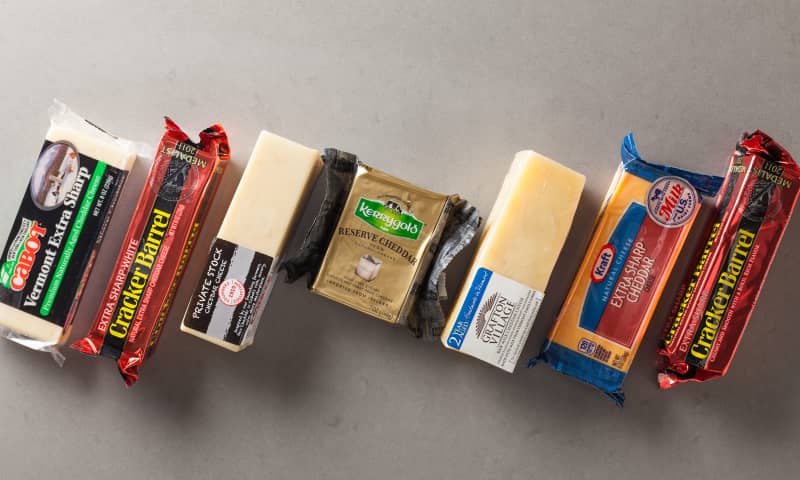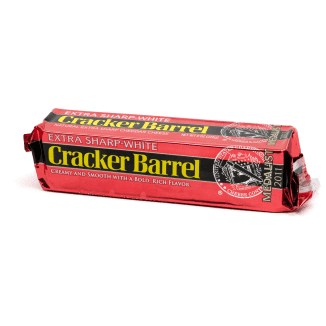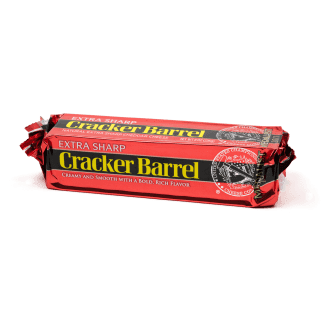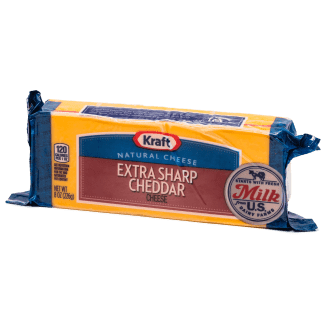American cheddar consumption has nearly doubled since 1970, and supermarket shelves are bursting with options, which makes choosing the best block a daunting task. Cheddar comes in a number of styles—mild, sharp, extra-sharp, and more. These terms aren’t regulated by the United States Food and Drug Administration (FDA), but they usually indicate how long a cheese has been aged. Typically, the older the cheese, the stronger it tastes, which is why we choose extra-sharp cheddar when we want bolder, punchier flavor.
Our mission: Find a versatile extra-sharp cheddar that is fantastic to eat plain but that also holds up decently in recipes where melting is required. To do so we selected seven top-selling nationally available cheddars that were either labeled “extra-sharp” or were aged for 12 to 24 months, which most experts agree is typical for extra-sharp cheddars. We tried them plain, in grilled cheese, and in our Simple Stovetop Macaroni and Cheese.
Fat and Moisture Aid Melting
Some cheddars that we loved plain for their complex, powerful funk and firm texture were oily and grainy when melted. Conversely, some cheeses that melted well were soft, chewy, and a bit bland when sampled plain. A few struck the perfect balance. How’d they get it right?
Dean Sommer, cheese and food technologist at the University of Wisconsin’s Center for Dairy Research, explained that the characteristics consumers like in a cheese-plate cheddar are at odds with the qualities prized for melting. The longer a cheese ages, the more time bacteria in the cheese have to break down the protein structure and form the flavor compounds responsible for the “sharp” flavor. This protein structure change causes an aged cheese to become more crumbly and drier and not great at melting.
The Age Conundrum
An older cheddar offers more intense flavor, but it loses the ability to melt perfectly as it ages. If you like bold flavor and aren't going to cook with it, select an older cheddar.
In our lineup, the cheeses that didn’t melt well were all aged for closer to 24 months. Kraft, the manufacturer of the three best melters (including our winner), wouldn’t tell us how long it ages its cheeses, but experts explained that their softer textures and slight give when squeezed meant that these cheeses were likely aged for about 12 months—a year less than some other cheddars.

But of the cheeses that we confirmed or suspected as being aged for about a year, some were flavorful while others were bland. To find out why, we sent all the cheeses to an independent lab to learn more about two key elements: moisture and fat. Aging usually has a direct impact on moisture in cheeses that are rinded or wrapped in porous materials, such as Parmigiano-Reggiano or cloth-bound cheddar, but supermarket cheddar blocks are wrapped in nonporous plastic and lose remarkably little moisture during aging (which takes place before they’re cut into smaller blocks and packaged for purchase). Moisture content doesn’t change with aging in supermarket cheddar, but the amount of moisture in the cheese can affect flavor perception and melting—as can the amount of fat. If the fat or moisture level is too low, a cheese can taste too sharp or even bitter and won’t melt well. On the other end of the spectrum, if a cheese has too much fat or moisture, it may melt well but will likely be bland, because the flavor is diluted by the fat and water.

The cheddars in our lineup ranged from 32 to 36 percent fat and from 33 to 37 percent moisture. And while a spread of 4 or 5 percent may not seem significant, Sommer said that a mere 1 percent difference in fat or moisture is enough to turn a versatile cheddar into a one-trick pony: either too firm to melt well or too soft for a cheese plate. Our winner contained a relatively high 35 percent fat and 36 percent moisture, which seems to be the ideal combination for sharp and flavorful cheese that melts well.
Cheddar Tastes Like Where It’s Made
We chose Cracker Barrel Extra Sharp White Cheddar Cheese as our winner. It not only melted beautifully but was also the runaway favorite for snacking. But we wondered: Why was Cracker Barrel’s orange cheddar lower in our ranking? In addition to using annatto, a natural food dye, this cheese was lower in fat and higher in moisture than our winner, so it’s likely that it was engineered to have a milder flavor.

Manufacturers sometimes make their white and orange cheddars different to suit regional preferences, but Sommer told us there’s another factor at play: terroir. Although Cracker Barrel wouldn’t confirm, these two cheeses are likely produced in different parts of the country, according to Sommer. He explained that extra-sharp cheddar, perhaps more than any other cheese, reflects its terroir because of two types of bacteria that are incorporated during production. The first are particularly delicate bacteria added by the cheesemakers. The second are more resilient “contaminant” cultures picked up from the air, milk, and environment. As the cheese ages, the inoculated bacteria die off while the contaminant bacteria grow. Since extra-sharp cheddar is aged for one to two years, contaminant bacteria have many months to flourish. And unlike other aged cheeses such as Gouda, Swiss, and Gruyère, cheddar isn’t made using flavor-forward enzymes or molds and isn’t “smeared” with cultures once aged. This means contaminant cultures, and thus the production location, have a particularly large impact on extra-sharp cheddar’s flavor.

Wherever it’s made, our tasters preferred the sharper, bolder Cracker Barrel offering to the milder orange option. But we recommend both, so whichever your preferred color, for extra-sharp cheddar, Cracker Barrel is the best supermarket choice.
The Not-So-United States of Cheddar
When it comes to extra-sharp cheddar, each region of the country has its own unique style and preferences. Here’s how they stack up.

- Taste plain
- Taste melted in grilled cheese sandwiches
- Taste in Simple Stovetop Macaroni and Cheese
- Taste yellow versus white Cracker Barrel cheeses blindfolded
- Lab tests of fat and moisture
- Likely aged for about a year
- Moderate fat and moisture levels for full flavor that still melts well












